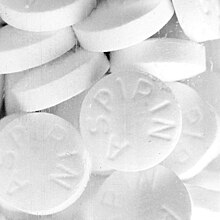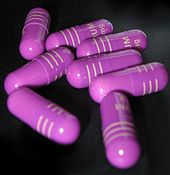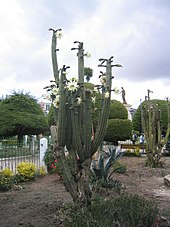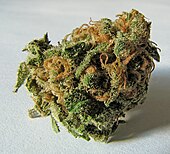Drug

Adrugis anychemical substanceother than a nutrient or an essential dietary ingredient, which, when administered to a living organism, produces a biological effect.[1]Consumption of drugs can be viainhalation,injection,smoking,ingestion,absorptionvia apatchon the skin,suppository,ordissolution under the tongue.
Inpharmacology,a drug is a chemical substance, typically of known structure, which, when administered to a living organism, produces a biological effect.[2]Apharmaceutical drug,also called a medication or medicine, is a chemical substance used totreat,cure,prevent,ordiagnoseadiseaseor to promotewell-being.[3]Traditionally drugs were obtained through extraction frommedicinal plants,but more recently also byorganic synthesis.[4]Pharmaceutical drugs may be used for a limited duration, or on a regular basis forchronic disorders.[3]
Classification
Pharmaceutical drugs are often classified intodrug classes—groups of related drugs that have similarchemical structures,the samemechanism of action(binding to the samebiological target), a relatedmode of action,and that are used to treat the same disease.[5][6]TheAnatomical Therapeutic Chemical Classification System(ATC), the most widely used drug classification system, assigns drugs a unique ATC code, which is an alphanumeric code that assigns it to specific drug classes within the ATC system. Another major classification system is theBiopharmaceutics Classification System.This classifies drugs according to their solubility and permeability orabsorptionproperties.[7]
Psychoactive drugsare substances that affect the function of thecentral nervous system,alteringperception,moodorconsciousness.[8]These drugs are divided into different groups like:stimulants,depressants,antidepressants,anxiolytics,antipsychotics,andhallucinogens.These psychoactive drugs have been proven useful in treating wide range ofmedical conditionsincludingmental disordersaround the world. The most widely used drugs in the world includecaffeine,nicotineandalcohol,[9]which are also consideredrecreational drugs,since they are used for pleasure rather than medicinal purposes.[10]All drugs can have potentialside effects.[11]Abuse of several psychoactive drugs can causeaddictionand/orphysical dependence.[12]Excessive use of stimulants can promotestimulant psychosis.Many recreational drugs areillicit;international treaties such as theSingle Convention on Narcotic Drugsexist for the purpose of theirprohibition.
Etymology
In English, the noun "drug" is thought to originate from Old French "drogue",possibly deriving from"droge(vate) "from Middle Dutch meaning" dry (barrels) ", referring to medicinal plants preserved as dry matter in barrels.[13][14]
In the 1990s however, SpanishlexicographerFederico Corriente Córdobadocumented the possible origin of the word in {ḥṭr}[15]an early romanized form ofAl-Andaluslanguage from Northwestern part of theIberian peninsula.[16]The term could approximately be transcribed as حطروكة orhatruka.[17]
The term "drug" has become askunked termwith negative connotation, being used as a synonym forillegal substanceslike cocaine or heroin or for drugs usedrecreationally.In other contexts the terms "drug" and "medicine" are used interchangeably.[18]
Efficacy
Drug action is highly specific and their effects may only be detected in certain individuals. For instance, the 10 highest-grossing drugs in the US may help only 4-25% of people.[19]Often, the activity of a drug depends on thegenotypeof a patient. For example, Erbitux (cetuximab) increases the survival rate ofcolorectal cancerpatients if they carry a particular mutation in theEGFRgene.[19]Some drugs are specifically approved for certain genotypes.Vemurafenibis such a case which is used formelanomapatients who carry a mutation inBRAFgene.[19]The number of people who benefit from a drug determines if drug trials are worth carrying out, given that phase III trials may cost between $100 million and $700 million per drug. This is the motivation behindpersonalized medicine,that is, to develop drugs that are adapted to individual patients.[19]
Medication

Amedicationormedicineis adrugtaken to cure or ameliorate any symptoms of anillnessor medical condition. The use may also be aspreventive medicinethat has future benefits but does not treat any existing or pre-existing diseases or symptoms. Dispensing of medication is often regulated bygovernmentsinto three categories—over-the-countermedications, which are available inpharmaciesand supermarkets without special restrictions;behind-the-countermedicines, which are dispensed by apharmacistwithout needing a doctor's prescription, andprescription only medicines,which must be prescribed by a licensedmedical professional,usually aphysician.[20]
In the United Kingdom, behind-the-counter medicines are calledpharmacy medicineswhich can only be sold in registered pharmacies, by or under the supervision of a pharmacist. These medications are designated by the letter P on the label.[21]The range of medicines available without a prescription varies from country to country. Medications are typically produced bypharmaceutical companiesand are oftenpatentedto give the developer exclusive rights to produce them. Those that are not patented (or with expired patents) are calledgeneric drugssince they can be produced by other companies without restrictions or licenses from the patent holder.[22]
Pharmaceutical drugs are usually categorised intodrug classes.A group of drugs will share a similarchemical structure,or have the samemechanism of action,the same relatedmode of actionor target the same illness or related illnesses.[5][6]TheAnatomical Therapeutic Chemical Classification System(ATC), the most widely used drug classification system, assigns drugs a uniqueATC code,which is an alphanumeric code that assigns it to specific drug classes within the ATC system. Another major classification system is theBiopharmaceutics Classification System.This groups drugs according to their solubility and permeability orabsorptionproperties.[7]
Spiritual and religious use


Some religions, particularlyethnic religions,are based completely on the use of certain drugs, known asentheogens,which are mostlyhallucinogens,—psychedelics,dissociatives,ordeliriants.Some entheogens includekavawhich can act as astimulant,asedative,aeuphoriantand ananesthetic.The roots of the kava plant are used to produce a drink consumed throughout the cultures of the Pacific Ocean.
Someshamansfrom different cultures use entheogens, defined as "generating the divine within,"[23]to achievereligious ecstasy.Amazonian shamans useayahuasca(yagé), a hallucinogenic brew, for this purpose.Mazatec shamanshave a long and continuous tradition of religious use ofSalvia divinorum,apsychoactiveplant. Its use is to facilitatevisionary states of consciousnessduring spiritual healing sessions.[24]
Silene undulatais regarded by theXhosa peopleas a sacred plant and used as an entheogen. Its roots are traditionally used to induce vivid (and according to the Xhosa, prophetic)lucid dreamsduring the initiation process ofshamans,classifying it a naturally occurringoneirogensimilar to the more well-known dream herbCalea ternifolia.[25]
Peyote,a small spinelesscactus,has been a major source of psychedelicmescalineand has probably been used byNative Americansfor at least five thousand years.[26][27]Most mescaline is now obtained from a few species of columnar cacti in particular fromSan Pedroand not from the vulnerable peyote.[28]
Theentheogenic use of cannabishas also been widely practised[29]for centuries.[30]Rastafariusemarijuana(ganja) as asacramentin theirreligious ceremonies.
Psychedelic mushrooms (psilocybin mushrooms), commonly calledmagic mushroomsorshroomshave also long been used as entheogens.
Smart drugs and designer drugs
Nootropics,also commonly referred to as "smart drugs", are drugs that are claimed to improve humancognitive abilities.Nootropics are used to improve memory, concentration, thought, mood, and learning. An increasingly used nootropic among students, also known as astudy drug,ismethylphenidatebranded commonly asRitalinand used for the treatment ofattention deficit hyperactivity disorder(ADHD) andnarcolepsy.[31]At high doses methylphenidatecan become highly addictive.[32]Serious addiction can lead topsychosis,anxietyand heart problems, and the use of this drug is related to a rise in suicides, and overdoses. Evidence for use outside of student settings is limited but suggests that it is commonplace.[31][32]Intravenous use of methylphenidate can lead toemphysematousdamage to the lungs, known asRitalin lung.[33]
Other drugs known asdesigner drugsare produced. An early example of what today would be labelled a 'designer drug' wasLSD,which was synthesised fromergot.[34]Other examples include analogs ofperformance-enhancing drugssuch as designersteroidstaken to improve physical capabilities; these are sometimes used (legally or not) for this purpose, often by professional athletes.[35]Other designer drugs mimic the effects of psychoactive drugs. Since the late 1990s there has been the identification of many of these synthesised drugs. In Japan and the United Kingdom this has spurred the addition of many designer drugs into a newer class of controlled substances known as atemporary class drug.
Synthetic cannabinoidshave been produced for a longer period of time and are used in the designer drugsynthetic cannabis.
Recreational drug use

Recreational drug useis the use of a drug (legal, controlled, or illegal) with the primary intention ofaltering the state of consciousnessthrough alteration of the central nervous system in order to create positive emotions and feelings. The hallucinogenLSDis a psychoactive drug commonly used as a recreational drug.[37]
Ketamineis a drug used foranesthesia,and is also used as a recreational drug, both in powder and liquid form, for its hallucinogenic anddissociative effects.[38]
Some national lawsprohibit the use of different recreational drugs; medicinal drugs that have the potential for recreational use are often heavily regulated. However, there are many recreational drugs that arelegal in many jurisdictionsand widely culturally accepted. Cannabisis the most commonly consumed controlled recreational drug in the world (as of 2012).[39]Its use in many countries is illegal but islegally usedin several countries usually with the proviso that it can only be used for personal use. It can be used in theleafform ofmarijuana(grass),or in the resin form ofhashish.Marijuana is a more mild form of cannabis than hashish.
There may be an age restriction on the consumption and purchase of legal recreational drugs. Some recreational drugs that are legal and accepted in many places includealcohol,tobacco,betel nut,andcaffeineproducts, and in some areas of the world the legal use of drugs such askhatis common.[40]
There are a number of legal intoxicants commonly calledlegal highsthat are used recreationally. The most widely used of these is alcohol.
Administration of drugs
All drugs have arouteofadministration,and many can be administered by more than one.
- Inhaled(breathed into the lungs) as anaerosol,inhaler,vapeor dry powder (this includes smoking or vaping a substance).
- Injectionas asolution,suspensionoremulsioneither:intramuscular,intravenous,intraperitoneal,intraosseous.
- Insufflation,as anasal sprayor snorting into the nose.
- Orally,as a liquid or solid, that is absorbed through theintestines.
- Rectallyas asuppository,that is absorbed by the rectum or colon.
- Sublingually,diffusing into the blood through tissues under the tongue.
- Topically,usually as acreamorointment.A drug administered in this manner may be given to act locally or systemically.[41]
- Vaginallyas apessary,primarily to treat vaginal infections.
Abolusis the administration of a medication, drug or other compound that is given to raise its concentration in blood rapdily to an effective level, regardless of the route of administration
Control of drugs
Numerous governmental offices in many countries deal with the control and supervision of drug manufacture and use, and the implementation of various drug laws. TheSingle Convention on Narcotic Drugsis an internationaltreatybrought about in 1961 to prohibit the use of narcotics save for those used inmedical researchand treatment. In 1971, a second treaty theConvention on Psychotropic Substanceshad to be introduced to deal with newer recreational psychoactive and psychedelic drugs.
Thelegal status ofSalvia divinorumvaries in many countries and even instates within the United States.Where it is legislated against, the degree of prohibition also varies.
TheFood and Drug Administration(FDA) in the United States is afederal agencyresponsible for protecting and promotingpublic healththrough theregulationand supervision offood safety,tobacco products,dietary supplements,prescriptionandover-the-countermedications,vaccines,biopharmaceuticals,blood transfusions,medical devices,electromagnetic radiationemitting devices,cosmetics,animal foods[42]andveterinary drugs.
In India, theNarcotics Control Bureau(NCB), anIndian federal law enforcementandintelligenceagency under theMinistry of Home Affairs,is tasked with combatingdrug traffickingand assisting international use of illegal substances under the provisions ofNarcotic Drugs and Psychotropic Substances Act.[43]
See also
Lists of drugs
- List of drugs
- List of pharmaceutical companies
- List of psychoactive plants
- List of Schedule I drugs (US)
References
- ^Ritter, James M.; MacEwan, David; Flower, Rod; Robinson, Emma; Henderson, Graeme; Fullerton, James; Loke, Yoon Kong (2024). "What is pharmacology?".Rang and Dale's pharmacology(Tenth ed.). London New York Oxford: Elsevier.ISBN978-0323873956.
- ^H.P., Rang; M.M, Dale; J.M., Ritter; R.J., Flower; G., Henderson (2011). "What is Pharmacology".Rang & Dale's pharmacology(7 ed.). Edinburgh: Churchill Livingstone. p. 1.ISBN978-0-7020-3471-8.
a drug can be defined as a chemical substance of known structure, other than a nutrient of an essential dietary ingredient, which, when administered to a living organism, produces a biological effect
- ^ab"Drug".Drug Definition & Meaning.The American Heritage Science Dictionary.Houghton Mifflin Company.Archivedfrom the original on 14 September 2007.Retrieved20 September2007– via dictionary.com.
- ^Atanasov AG, Waltenberger B, Pferschy-Wenzig EM, Linder T, Wawrosch C, Uhrin P, Temml V, Wang L, Schwaiger S, Heiss EH, Rollinger JM, Schuster D, Breuss JM, Bochkov V, Mihovilovic MD, Kopp B, Bauer R, Dirsch VM, Stuppner H (December 2015)."Discovery and resupply of pharmacologically active plant-derived natural products: A review".Biotechnol Adv.33(8): 1582–614.doi:10.1016/j.biotechadv.2015.08.001.PMC4748402.PMID26281720.
- ^abMahoney A, Evans J (6 November 2008). "Comparing drug classification systems".AMIA Annual Symposium Proceedings:1039.PMID18999016.
- ^abWorld Health Organization (2003).Introduction to drug utilization research(PDF).Geneva: World Health Organization. p. 33.ISBN978-92-4-156234-8.Archived fromthe original(PDF)on 2016-01-22.
- ^abBergström, CA; Andersson, SB; Fagerberg, JH; Ragnarsson, G; Lindahl, A (16 June 2014). "Is the full potential of the biopharmaceutics classification system reached?".European Journal of Pharmaceutical Sciences.57:224–31.doi:10.1016/j.ejps.2013.09.010.PMID24075971.
- ^"An overview of alcohol and other drug issues".Archived fromthe originalon 2015-03-28.Retrieved2015-03-16.
- ^Crocq MA (June 2003)."Alcohol, nicotine, caffeine, and mental disorders".Dialogues Clin. Neurosci.5(2): 175–185.doi:10.31887/DCNS.2003.5.2/macrocq.PMC3181622.PMID22033899.
- ^"Recreational Drug".The Free Dictionary.Archivedfrom the original on 15 September 2015.Retrieved16 March2015.
- ^"MHRA Side Effects of Medicines."Archived2014-05-02 at theWayback MachineMHRA Side Effects of Medicines,
- ^Fox, Thomas Peter; Oliver, Govind; Ellis, Sophie Marie (2013)."The Destructive Capacity of Drug Abuse: An Overview Exploring the Harmful Potential of Drug Abuse Both to the Individual and to Society".ISRN Addiction.2013:450348.doi:10.1155/2013/450348.PMC4392977.PMID25938116.
- ^Harper, Douglas."drug".Online Etymology Dictionary.
- ^Tupper KW (2012). "Psychoactive substances and the English language:" Drugs, "discourses, and public policy".Contemporary Drug Problems.39(3): 461–492.doi:10.1177/009145091203900306.S2CID55498558.
- ^Corriente Córdoba, Federico (1997).Dictionary of Andalusi Arabic.Leiden:Brill Publishers.p. 130.ISBN978-90-04-09846-6.
- ^"Reflejos iberorromances del Andalusí (ḥṭr)"[Ibero-Romance reflections of the Andalusí (ḥṭr)].Al-Andalus Magreb.I:77–87. 1993.
- ^Anders, V; et al. (2001–2020)."Droga".Etimologías de Chile(in Spanish).Retrieved2023-02-17.
- ^Zanders ED (2011)."Introduction to Drugs and Drug Targets".The Science and Business of Drug Discovery:11–27.doi:10.1007/978-1-4419-9902-3_2.ISBN978-1-4419-9901-6.PMC7120710.
- ^abcdSchork, Nicholas J. (April 2015)."Personalized medicine: Time for one-person trials".Nature.520(7549): 609–611.doi:10.1038/520609a.ISSN1476-4687.
- ^"About Registration: Medicines and Prescribing".Health and Care Professions Council.Archivedfrom the original on 2016-01-13.Retrieved22 January2016.
- ^"Glossary of MHRA terms – P".U.K.Medicines and Healthcare products Regulatory Agency.Archivedfrom the original on 2008-11-14.Retrieved2008-11-05.
- ^""Generic Drugs", Center for Drug Evaluation and Research, U.S. Food and Drug Administration "(PDF).Fda.gov.Archived(PDF)from the original on 29 August 2017.Retrieved11 October2017.
- ^Entheogen,[dictionary.com],archivedfrom the original on 2012-02-13,retrieved2012-03-13
- ^Valdés, Díaz & Paul 1983,p. 287.
- ^Sobiecki, Jean-Francois (July 2012). "Psychoactive Spiritual Medicines and Healing Dynamics in the Initiation Process of Southern Bantu Diviners".Journal of Psychoactive Drugs.44(3): 216–223.doi:10.1080/02791072.2012.703101.PMID23061321.S2CID32876088.
- ^El-Seedi HR, De Smet PA, Beck O, Possnert G, Bruhn JG (October 2005). "Prehistoric peyote use: alkaloid analysis and radiocarbon dating of archaeological specimens of Lophophora from Texas".J Ethnopharmacol.101(1–3): 238–42.doi:10.1016/j.jep.2005.04.022.PMID15990261.
- ^"A Brief History of the San Pedro Cactus".Mescaline.com.Archivedfrom the original on 28 September 2016.Retrieved11 October2017.
- ^Terry M (2013)."Lophophora williamsii".IUCN Red List of Threatened Species.2013.doi:10.2305/IUCN.UK.2013-1.RLTS.T151962A581420.en.Retrieved2018-10-29.
- ^Souza, Rafael Sampaio Octaviano de; Albuquerque, Ulysses Paulino de; Monteiro, Júlio Marcelino; Amorim, Elba Lúcia Cavalcanti de (October 2008)."Jurema-Preta (Mimosa tenuiflora [Willd.] Poir.): a review of its traditional use, phytochemistry and pharmacology".Brazilian Archives of Biology and Technology.51(5): 937–947.doi:10.1590/S1516-89132008000500010.
- ^Bloomquist, Edward (1971).Marijuana: The Second Trip.California: Glencoe.
- ^abAbelman, D (6 October 2017)."Mitigating risks of students use of study drugs through understanding motivations for use and applying harm reduction theory: a literature review".Harm Reduct J.14(1): 68.doi:10.1186/s12954-017-0194-6.PMC5639593.PMID28985738.
- ^abSmith, M; Farah, M (September 2011)."Are prescription stimulants" smart pills "? The epidemiology and cognitive neuroscience of prescription stimulant use by normal healthy individuals".Psychol. Bull.137(5): 717–41.doi:10.1037/a0023825.PMC3591814.PMID21859174.
- ^Sharma, R."Ritalin lung".Radiopedia.org.Archivedfrom the original on 30 July 2020.Retrieved1 July2019.
- ^"Discovery And Synthesis Of LSD: What You Probably Did Not Know About It - Chemistry Hall".2017-06-13. Archived fromthe originalon 2017-06-13.Retrieved2017-06-13.
- ^Teale P, Scarth J, Hudson S (2012). "Impact of the emergence of designer drugs upon sports doping testing".Bioanalysis.4(1): 71–88.doi:10.4155/bio.11.291.PMID22191595.
- ^Lingeman (1970).Drugs from A–Z: A Dictionary.Penguin.ISBN978-0-7139-0136-8.
- ^"DrugFacts: Hallucinogens - LSD, Peyote, Psilocybin, and PCP".National Institute on Drug Abuse. December 2014.Archivedfrom the original on February 16, 2015.RetrievedFebruary 17,2015.
- ^Morgan, CJ; Curran, HV; Independent Scientific Committee on, Drugs. (January 2012). "Ketamine use: a review".Addiction.107(1): 27–38.doi:10.1111/j.1360-0443.2011.03576.x.PMID21777321.S2CID11064759.
- ^"World Drug Report 2012"(PDF).UNODC.2012. p. 69.Archived(PDF)from the original on 13 July 2012.Retrieved9 December2016.
- ^Al-Mugahed, Leen (2008)."Khat Chewing in Yemen: Turning over a New Leaf: Khat Chewing Is on the Rise in Yemen, Raising Concerns about the Health and Social Consequences".Bulletin of the World Health Organization.86(10): 741–2.doi:10.2471/BLT.08.011008.PMC2649518.PMID18949206.Archivedfrom the original on 10 March 2016.Retrieved22 January2016.
- ^"The administration of medicines".Nursing Times.EMAP Publishing Limited. 19 November 2007.Archivedfrom the original on 17 June 2010.Retrieved11 January2016.
- ^"Animal Food & Feeds".Fda.gov.Archivedfrom the original on 22 March 2015.Retrieved14 March2015.
- ^"Narcotics Control Bureau".2009-04-10. Archived fromthe originalon 2009-04-10.Retrieved2020-09-12.
Further reading
- Richard J. Miller (2014).Drugged: the science and culture behind psychotropic drugs.Oxford University Press.ISBN978-0-19-995797-2.
External links
- DrugBank,a database of 13,400 drugs and 5,100 protein drug targets
- "Drugs",BBC Radio 4 discussion with Richard Davenport-Hines, Sadie Plant and Mike Jay (In Our Time,May 23, 2002)
